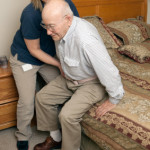Home care services for seniors are a great way to meet the needs of your family by hiring an individual to provide care in the home. The cost of long-term care, can be  expensive, this includes home and community based services (HCBS) and facility based care services (FBCS). The cost for services provided in the home are usually less than those provided in a facility.
expensive, this includes home and community based services (HCBS) and facility based care services (FBCS). The cost for services provided in the home are usually less than those provided in a facility.
Paying for Home Care Services
One misconception regarding long-term care services is that it can be paid for with Medicare. Medicare is a health insurance program available to individuals age 65 and older. This program does not pay for long-term care, but does pay for short term “skilled” care, or rehabilitation. As a health insurance program, the two main parts of Medicare, Part A and B, pay for a certain amount of days of hospitalization or medication associated with that hospitalization (a prescription drug benefit is covered under a separate Medicare Part D).
To pay for long-term home care services you need private long-term care insurance, Medicaid (an entitlement program for low-income persons) and other private sources.
The Cost of Services in the Home
The cost of providing services in the home varies by state and region. These costs will be higher in areas of the country that have a higher population of older Americans (i.e. Florida, Arizona, etc.) and lower in states that have a lower number of older persons (i.e. North Dakota and Montana). It is always best to talk to the home care agency to find out the types of care they provide and the hourly or live-in home care rates.
How Home Care Services Help
Companions may provide a wide array of services, including:
- Accompany the client on doctor’s visits when necessary
- Shopping and performing other household errands
- Reminding clients to take their medication
- Providing hygiene assistance
- Supervising ambulation and helping to prevent falls
- Taking care of all personal laundry and bed linens for the client
- Preparing and serving meals according to client’s dietary needs
- Cleaning the bathroom and kitchen after use, including washing dishes after meals and mopping the floor
- Making and changing the bed
- Cleaning the client’s room, which includes dusting and vacuuming
- Providing respite for family caregivers
- Helping with correspondence to family and friends
- Providing socialization, friendship and support for the client
- Going on walks and encouraging and participating in stimulating activities
